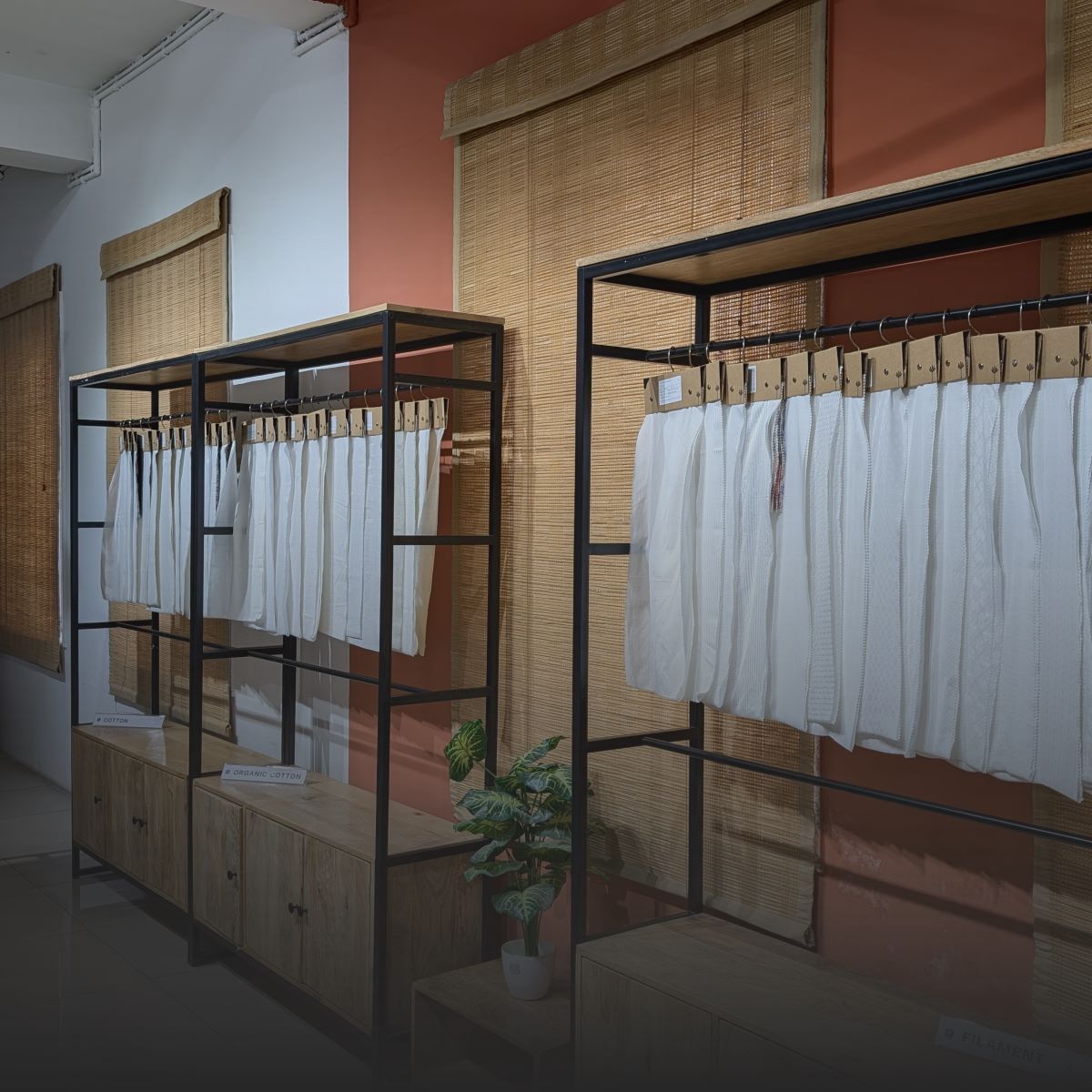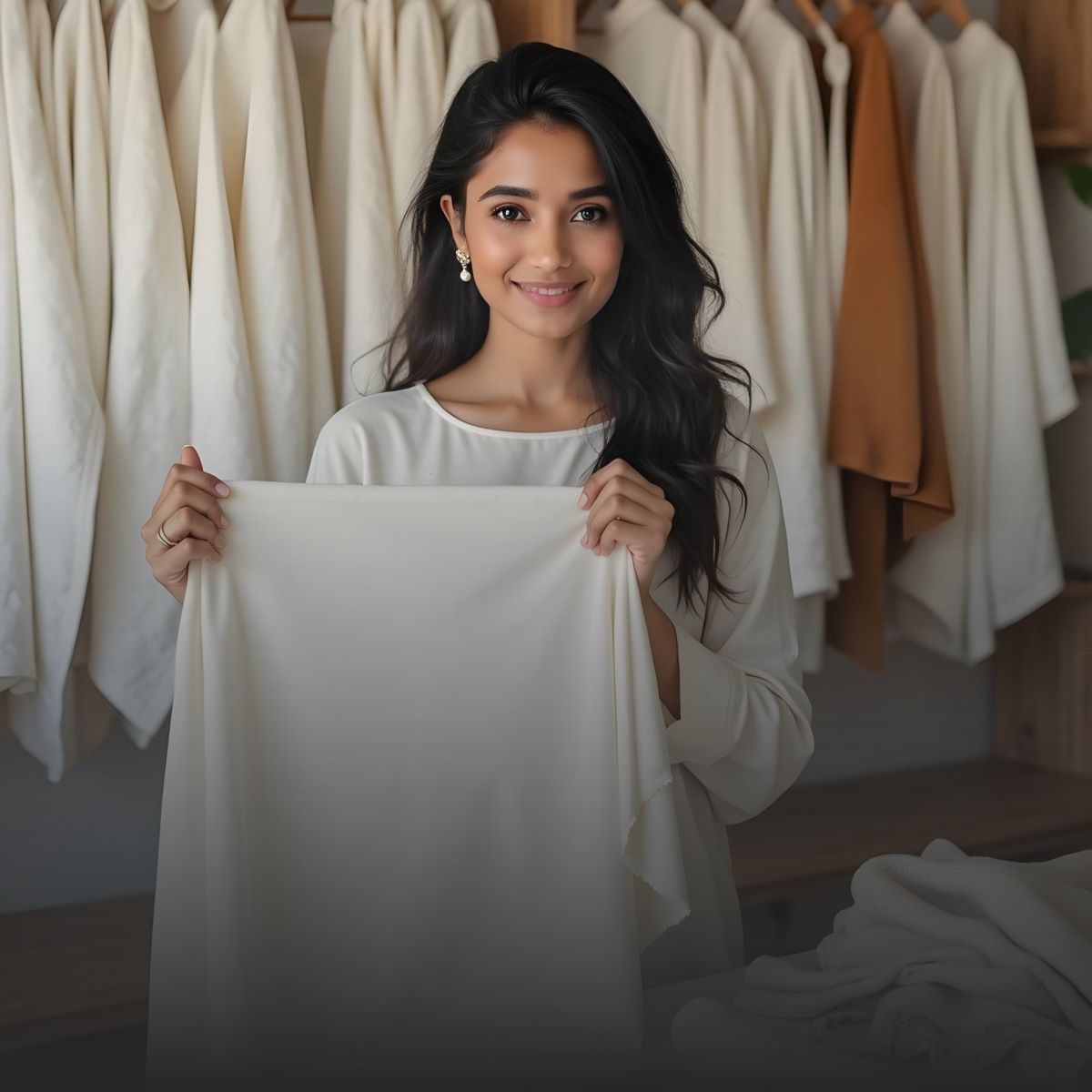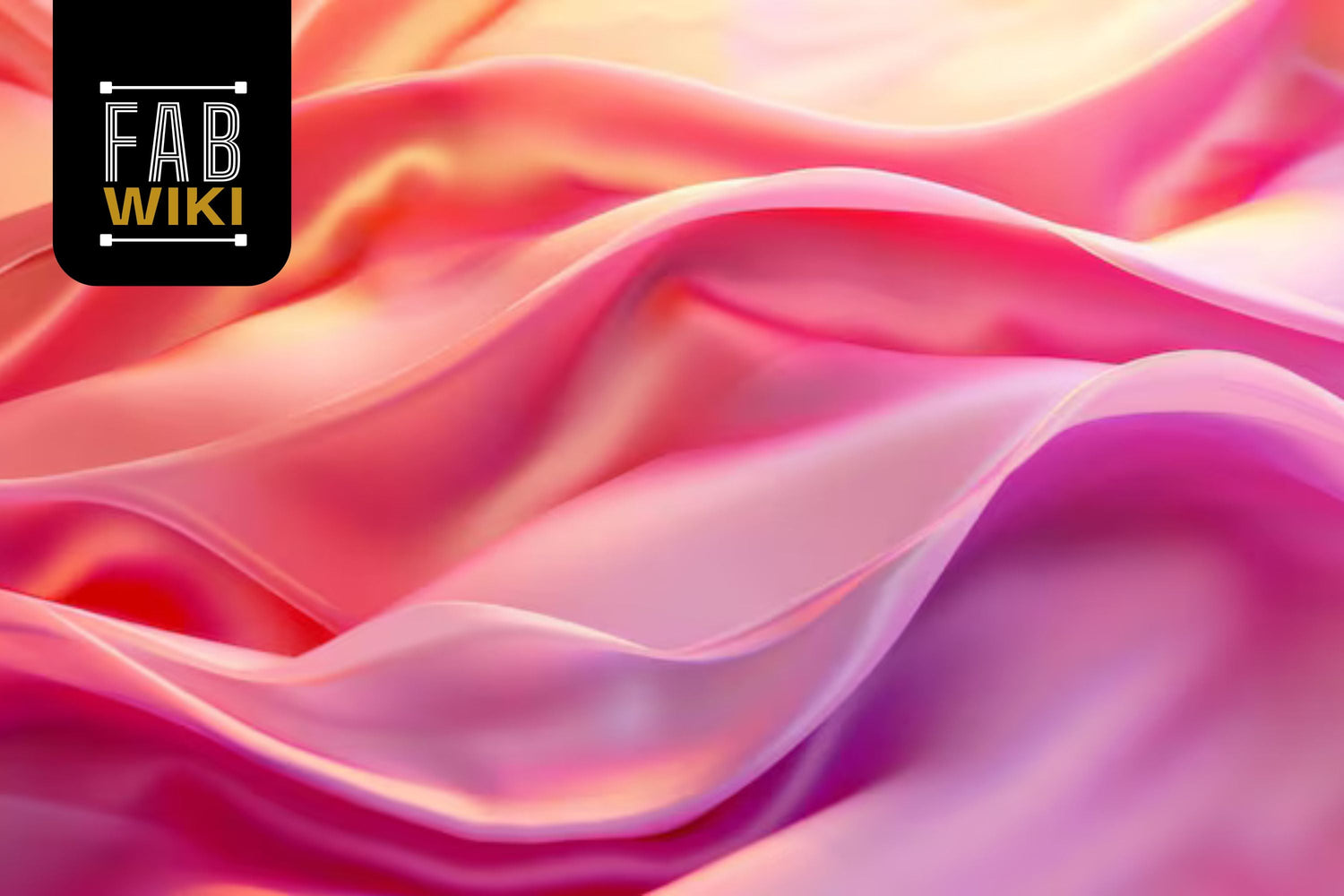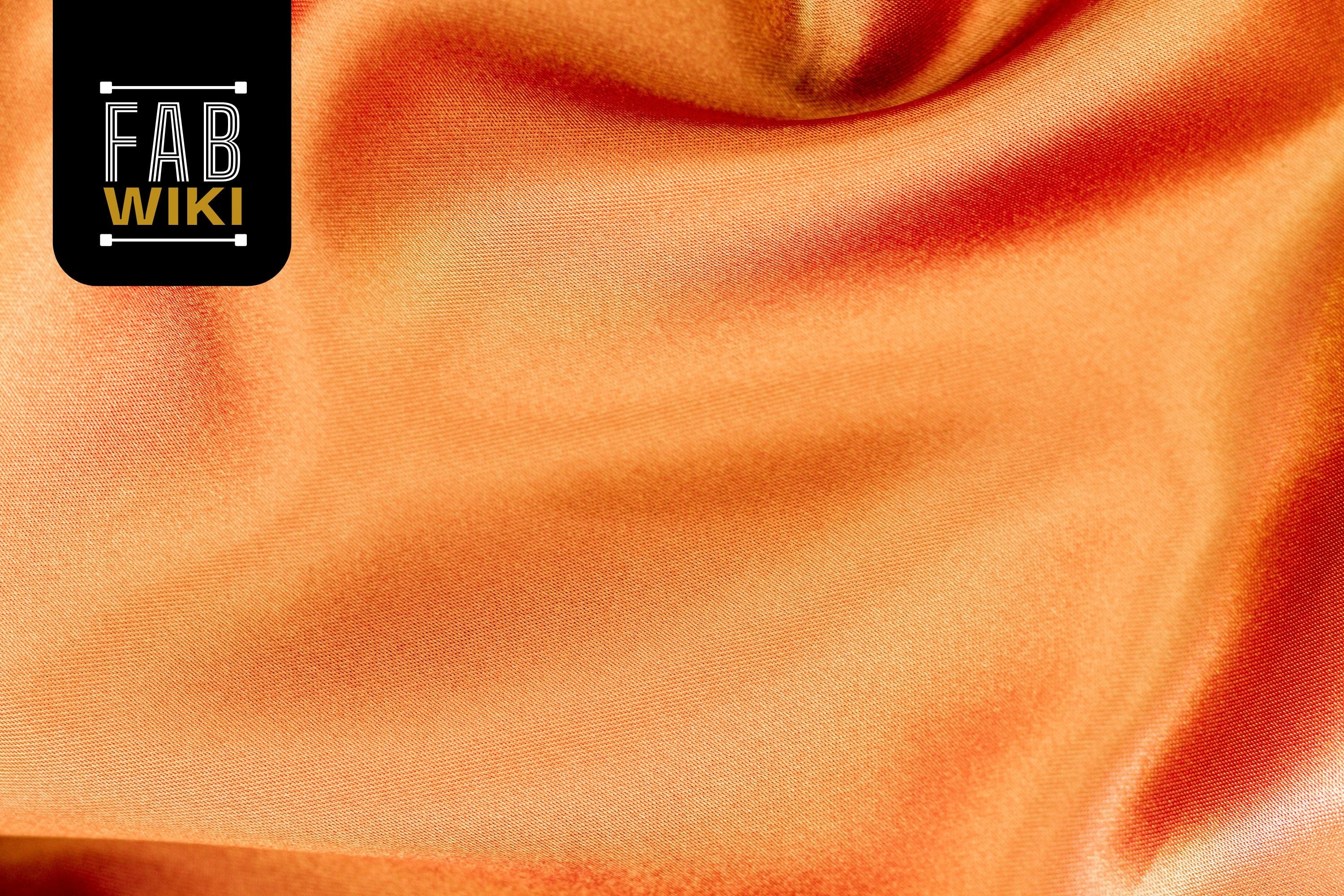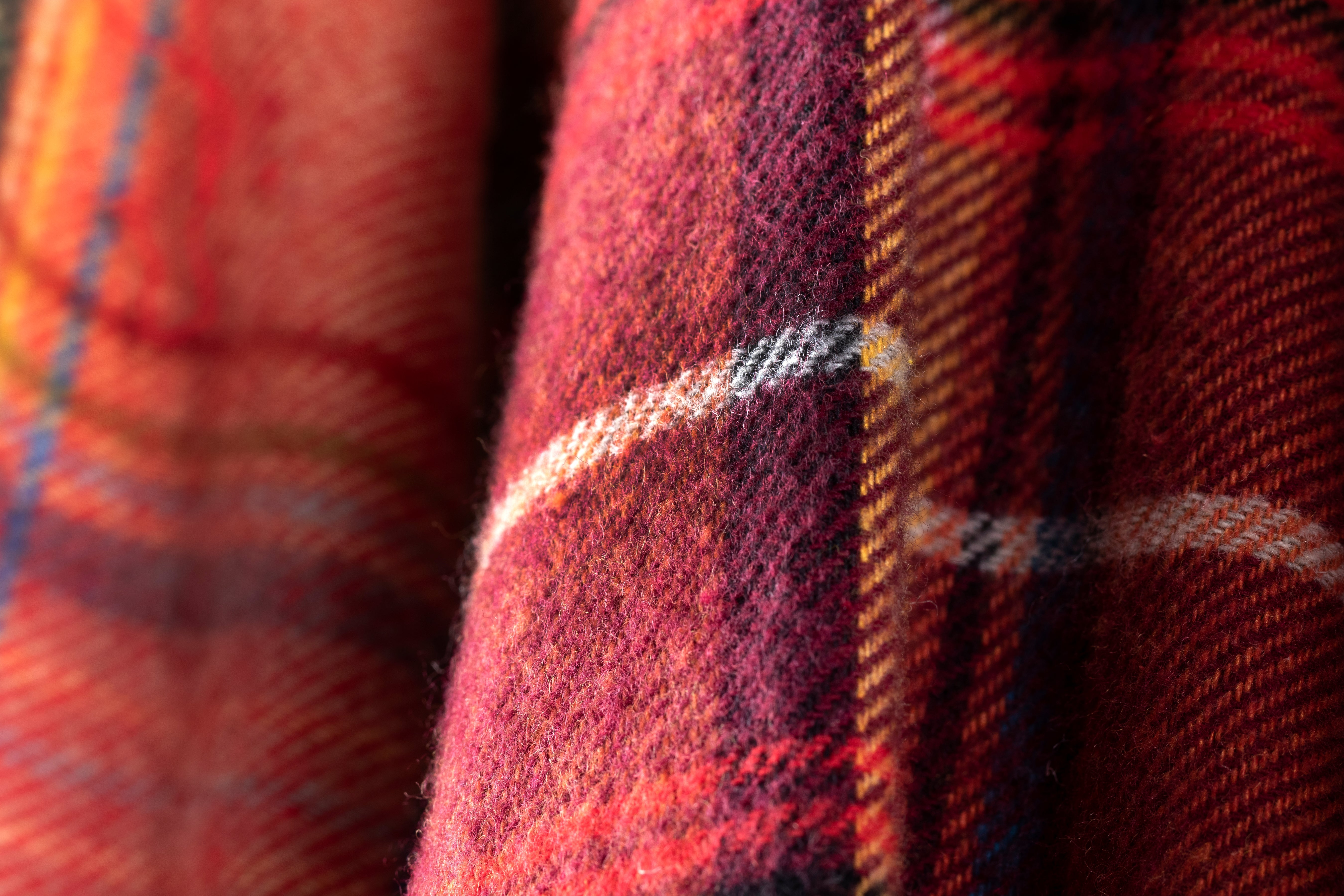Flowy fabrics are the backbone of modern womenswear and resortwear design — delivering elegance, movement, and comfort. From luxurious silk charmeuse to sustainable Tencel™ and breathable viscose challis, these fabrics shape the way garments fall, move, and feel.
For designers, sourcing managers, and textile buyers, understanding what makes a fabric flowy goes beyond aesthetic appeal — it's a technical balance between GSM, GLM, weave structure, yarn fineness, drape coefficient, and finishing treatments.
This guide decodes every aspect of flowy fabrics — their technical behaviour, key properties, sourcing specifications, GSM–GLM relation, weave and yarn details, and how to select the best option for each product category.
What Is Flowy Fabric?

Flowy fabric isn't a fiber type — it's a descriptive term used for fabrics with low stiffness, soft hand, and high drape coefficient, meaning they hang and move smoothly with the wearer's body.
Flowy behavior depends on fiber chemistry, yarn count, weave/knit structure, and finishing processes such as softening or silicone coating. These fabrics are known as drapey, fluid, or liquid fabrics in textile engineering.
Technical parameters defining flowy fabrics:
- GSM (grams per square meter): Light-to-medium weight, typically 60–200 GSM.
- GLM (grams per linear meter): Usually 90–250 GLM, depending on fabric width.
- Drape coefficient: <40% (ASTM D1388) — indicates fluid motion.
- Bending stiffness / Flexural rigidity: Lower values = higher flow.
- Yarn count (Ne / Tex / Denier): Finer yarns (40s–100s Ne or 20–40 Denier) ensure smoother drape.
- Weave: Satin, plain, or crepe weaves maximize flow.
-
Luster: Soft sheen from filament yarns or finishing enhances the elegant, liquid look.
Why Flowy Fabrics Matter for Design & Sourcing
Flowy fabrics directly affect how garments behave in motion. The drape impacts:
- Silhouette — creates feminine, flattering shapes.
- Comfort — enhances breathability and softness.
- Manufacturing — affects pattern cutting, seam handling, and yield.
- Consumer perception — fluidity adds premium appeal, even in cost-effective fibers.
For brands, choosing the right flowy fabric ensures the product looks luxurious but performs well in production and daily wear.
Core Characteristics of Flowy Fabrics
Before we dive into types, let's understand what defines these fabrics technically and visually.
Key properties:
- Low stiffness — folds softly instead of holding shape.
- High drape coefficient — fabric hangs naturally and follows body movement.
- Light-to-mid GSM — between 60–200 GSM for apparel use.
- Soft handfeel — smooth against skin, essential for blouses and dresses.
- Good colour absorption — compatible with reactive and digital prints.
- Breathable and comfortable — natural or regenerated cellulosic options like viscose and lyocell excel here.
- Variable care needs — washable (modal/viscose) to dry-clean only (silk).
Primary Flowy Fabric Families (Designers' Favourites)
Different fibers achieve flow differently. Below is a comprehensive technical table covering popular flowy fabric bases with GSM, weave, luster, and performance traits.
|
Fabric Type |
Technical Composition & Weave |
Weight (GSM / GLM) & Luster |
Key Traits & Common Uses |
|
Silk Charmeuse / Crepe de Chine |
100% Silk, Satin or Crepe weave |
60–120 GSM / 90–160 GLM, High luster |
Luxurious hand, natural sheen, ideal for eveningwear & couture dresses |
|
Viscose Challis / Rayon Crepe |
Regenerated cellulose, Plain or Crepe weave |
80–160 GSM / 110–180 GLM, Medium luster |
Soft, breathable, prints beautifully; used for dresses & tops |
|
Lyocell / Tencel™ |
Sustainable wood pulp fiber, Plain or Twill weave |
90–160 GSM / 120–200 GLM, Moderate luster |
Eco-friendly, high wet strength, cool touch; perfect for resortwear |
|
Modal / Modal Satin |
Regenerated cellulose, Satin or Knit construction |
120–200 GSM / 150–240 GLM, Medium-high luster |
Soft, silky, washable, breathable; ideal for blouses & loungewear |
|
Polyester Chiffon / Georgette |
Synthetic filament yarns, Plain or Crepe weave |
30–90 GSM / 60–150 GLM, High luster |
Lightweight, durable, wrinkle-resistant; used for scarves & overlays |
|
Crepe (Woven or Knit) |
Silk, viscose, or poly, Crepe/Twill structure |
100–220 GSM / 130–250 GLM, Moderate luster |
Textured, elastic, elegant fall; ideal for skirts & dresses |
|
Jersey (Viscose/Modal Blend) |
Regenerated blend, Knit construction |
150–250 GSM / 180–300 GLM, Medium luster |
Stretchy, drapey, breathable; great for wrap dresses & tees |
|
Satin (Silk/Viscose/Poly) |
Various fibers, Satin weave |
100–220 GSM / 150–280 GLM, High luster |
Glossy, bias-friendly, fluid; perfect for gowns, slips & lingerie |
GSM & GLM — Understanding Fabric Weight and Drape
GSM (grams per square meter) indicates how heavy the fabric feels.
GLM (grams per linear meter) helps calculate roll handling and fabric yield.
Lighter fabrics (below 100 GSM) drape more fluidly; heavier ones offer more body and structure.
|
GSM Range |
GLM (Approx.) |
Typical Weave / Knit |
Drape Quality |
Ideal Applications |
|
50–100 |
90–150 |
Plain / Chiffon / Voile |
Very fluid, airy |
Scarves, overlays, summer dresses |
|
100–160 |
140–220 |
Challis / Satin / Crepe |
Soft & balanced |
Blouses, skirts, lined dresses |
|
160–220 |
200–280 |
Jersey / Twill / Satin |
Moderate structure |
Pants, bias-cut dresses |
|
220+ |
280–350 |
Heavier knits / satin twill |
Controlled drape |
Structured yet fluid silhouettes |
Weave Structures That Create Flow

Weave and yarn configuration define how a fabric bends and moves.
- Plain weave — balanced, uniform drape (used in challis and voile).
- Satin weave — smooth face and high luster (used in charmeuse and satin).
- Crepe weave — irregular texture adds bounce and movement.
- Twill weave — diagonal texture, better strength, soft drape (common in Tencel™ twills).
- Knits (jersey/interlock) — natural stretch and high flexibility, perfect for body drape.
Technical tip:
Flowy fabrics usually use low-twist filament yarns (8–10 TPI) or fine spun yarns (40s–100s Ne) to maintain flexibility and surface smoothness.
Luster & Surface Finish
Luster refers to how light reflects on the surface — an essential aesthetic factor for flowy fabrics.
High-lustre flowy fabrics: Silk satin, viscose satin, polyester charmeuse.
Matte flowy fabrics: Crepe, modal, lyocell twill.
Common finishing treatments that enhance flow and shine:
- Softening finish (enzyme/silicone) — Improves drape and handfeel.
- Bio-polish / Peach finish — Removes fuzz, adds smoothness.
- Calendering / Polishing — For satins to enhance luster.
- Tumble wash / Air finish — Creates a relaxed, lived-in drape.
Drape & Mechanical Testing Metrics
Laboratory tests quantify flow and softness — key for export and high-end apparel buyers.
|
Test |
Purpose |
Ideal Range for Flowy Fabrics |
|
Drape Coefficient (ASTM D1388) |
Measures hang & folding |
≤ 40% |
|
Bending Length (Cantilever Test) |
Fabric stiffness |
≤ 1.8 cm (lightweight) |
|
Flexural Rigidity |
Resistance to bending |
Low (≤0.2 mg.cm) |
|
Air Permeability (CFM) |
Breathability |
80–150 CFM |
|
Tensile Strength |
Durability |
> 25 N warp/weft |
|
Shrinkage |
Dimensional stability |
≤ 3% lengthwise |
|
Pilling (Martindale) |
Surface durability |
Grade ≥ 4 |
Printability & Dyeing Options
Flowy fabrics hold color beautifully but require precise process-matching.
For cellulosic bases (viscose, modal, lyocell):
- Reactive dyeing — deep, washfast shades.
- Digital inkjet printing — vibrant, precise motifs.
- Pigment printing — economical for lighter bases.
For polyester bases:
-
Disperse dyeing / Sublimation — for chiffon, satin, crepe.
Eco options:
-
Azo-free dyes, low-water reactive systems, and digital pigment printing for reduced waste.
Quality checks:
Shade continuity, wash fastness, crocking resistance, and drape retention after printing.
How to Source Flowy Fabrics in Bulk
Step-by-step sourcing workflow for brands:
- Define brief — specify GSM, weave, finish, width, and end-use.
- Request swatches — 10×12 cm and 1–2 m sample yardage for drape tests.
- Run trial prints — verify color, shrinkage, and surface behavior.
- Lab test approval — check drape coefficient, shrinkage, and fastness.
- Confirm MOQ & timeline — low-MOQ suppliers (from 1–100 m) for sampling.
- Bulk production — once approved, typical lead time 3–6 weeks.
- QC & logistics — ensure export documentation and shade reports.
(Platforms like Fabriclore provide mill-level customization, including Pantone matching, GSM adjustment, and low MOQ sampling for flowy fabrics.)
Production & Handling Recommendations
Flowy fabrics hold colour beautifully but require precise process-matching.
For cellulosic bases (viscose, modal, lyocell):
- Reactive dyeing — deep, washfast shades.
- Digital inkjet printing — vibrant, precise motifs.
- Pigment printing — economical for lighter bases.
For polyester bases:
-
Disperse dyeing / Sublimation — for chiffon, satin, crepe.
Eco options:
-
Azo-free dyes, low-water reactive systems, and digital pigment printing for reduced waste.
Quality checks:
Shade continuity, wash fastness, crocking resistance, and drape retention after printing.
How to Source Flowy Fabrics in Bulk

Step-by-step sourcing workflow for brands:
- Define brief — specify GSM, weave, finish, width, and end-use.
- Request swatches — 10×12 cm and 1–2 m sample yardage for drape tests.
- Run trial prints — verify colour, shrinkage, and surface behaviour.
- Lab test approval — check drape coefficient, shrinkage, and fastness.
- Confirm MOQ & timeline — low-MOQ suppliers (from 1–100 m) for sampling.
- Bulk production — once approved, typical lead time 3–6 weeks.
- QC & logistics — ensure export documentation and shade reports.
(Platforms like Fabriclore provide mill-level customisation, including Pantone matching, GSM adjustment, and low MOQ sampling for flowy fabrics.)
Production & Handling Recommendations
Working with flowy fabrics requires precision during cutting and stitching.
- Cutting: To stop slippage, use rotary blades and a single-layer plan.
- Stitching: Fine needles (70/10 to 80/12) and microtex threads should be used.
- Seams: For sheers, use French seams, rolled hems, or overlock.
- Connecting: Only use lightweight fusible (woven or linen) when it's necessary.
- It's a press: To keep things from shining, use low heat and a press cloth.
- Getting stable: Digital pictures should be backed with spray starch or paper to keep them from warping.
Sustainability in Flowy Fabrics
Flowy doesn't have to mean wasteful. Modern mills now combine aesthetics with eco-responsibility.
- Preferred fibers: Lyocell (Tencel™), LENZING™ Modal, organic cotton blends.
- Recycled options: GRS-certified recycled polyester chiffon/satin.
- Low-impact processing: Azo-free dyes, digital printing, closed-loop solvents.
- Certifications to seek: OEKO-TEX®, LENZING™, GOTS, FSC, GRS.
Sustainability tip:
Lyocell's closed-loop production recovers 99% of water and solvents, making it the most eco-friendly among flowy fibers.
Matching Flowy Fabrics to Garment Types
|
Garment |
Best Flowy Fabrics |
Technical Reason |
|
Bias-cut gown |
Silk charmeuse, viscose satin |
High luster, low stiffness, graceful fall |
|
Maxi skirt |
Viscose challis, modal crepe |
Fluid swing, breathable, light GSM |
|
Blouse / cami |
Lyocell, lightweight silk |
Soft hand, moderate opacity |
|
Scarf / overlay |
Polyester chiffon, silk georgette |
Lightweight, airy, high drape coefficient |
|
Resortwear tunic |
Tencel™, modal voile |
Cool hand, eco appeal, flowy yet strong |
|
Loungewear |
Modal jersey, viscose jersey |
Stretch + fluidity for comfort |
Cost & Lead Time Overview
|
Fabric Type |
Average Cost (per meter) |
Lead Time (bulk) |
|
Viscose / Rayon |
₹250–₹450 |
3–5 weeks |
|
Lyocell / Tencel™ |
₹450–₹700 |
4–6 weeks |
|
Modal / Modal Jersey |
₹350–₹550 |
3–5 weeks |
|
Silk |
₹800–₹1500+ |
6–8 weeks |
|
Polyester Chiffon / Satin |
₹180–₹300 |
2–4 weeks |
Supplier Checklist for Flowy Fabric Procurement
Before placing your order, confirm:
- Physical swatches (RFD & dyed).
- GSM & GLM tolerance ±5%.
- Lab reports (shrinkage, colourfastness, pilling).
- Pantone-matched shade bands.
- Certification (OEKO-TEX® / LENZING™ / GRS).
- MOQ & repeat order consistency.
- QC inspection + export documentation.
Final Thoughts — Balancing Aesthetics & Engineering
Flowy fabrics combine art and science — they bring visual grace but demand technical precision. Designers and brands should align fiber chemistry (viscose, lyocell, silk) with engineering parameters (GSM, GLM, weave, drape coefficient) and sustainable sourcing practices.
For best results:
- Use viscose or lyocell challis for affordable fluidity.
- Use modal and Tencel™ for soft, eco-conscious drapes.
- Use polyester satin or chiffon for scalability and wrinkle resistance.
Platforms like Fabriclore can support on-demand flowy fabric sourcing, including Pantone matching, GSM adjustment, digital printing, and low MOQ sampling (from 1 m–100 m) — helping brands design smarter, scale sustainably, and stay trend-forward.
FAQs — What Buyers Frequently Search
Q1. Which Is The Best Flowy Fabric For Printed Summer Dresses?
Viscose challis and Tencel™ Lyocell are ideal — light (80–140 GSM), breathable, and excellent for digital reactive printing with soft fall.
Q2. How Can I Identify A High-Quality Flowy Fabric?
Check drape coefficient (<40%), GSM range (60–200), soft luster, and even handfeel. Request lab test data for shrinkage and tensile strength.
Q3. What Weave Is Most Suitable For Flowy Blouses?
Plain or satin weaves with fine yarns (40s–80s Ne) ensure a supple drape. Crepe weaves add bounce for structured flow.
Q4. Are Polyester Chiffons And Satins Sustainable?
Standard polyester isn't, but recycled polyester (rPET) with GRS certification is a better option for scalable, eco-conscious production.
Q5. What Care Method Preserves Flowy Fabrics Best?
- Hand wash or delicate machine cycle in cold water.
- Avoid bleach and wringing.
- Iron on low heat, reverse side.
- Hang dry to retain drape and sheen.
We also happen to be a magnet for suggestions, and would love to catch yours….throw us yours on hello@fabriclore.com
